The Acer Swift 3 SF314 Notebook Review: Swift Gets Swifter With Ryzen 4000
by Brett Howse & Andrei Frumusanu on May 5, 2020 8:00 AM ESTDisplay Analysis
Acer offers just a single display option on the 14-inch AMD based Swift 3, which is a 1920x1080 IPS display. Considering the price, this is the right option, although it is interesting that they are offering a 13.5-inch 3:2 Intel based Swift 3 in the SF313-52. The 3:2 works quite well for productivity, although less-so for gaming where 16:9 generally suffers from fewer issues.
There is no touch capability with this display, which is a bit of a shame, but also understandable with the other features offered. Acer did well to hit their target price range, and they made overall good decisions on where to invest. Touch is a nice to have, but not a necessity, although when you are used to having it, it is amazing how often you try to touch the screen.
To see how the display stacks up, the laptop was tested with Portrait Display’s CalMAN software suite. For brightness and contrast, the X-Rite i1Display Pro colorimeter was used, and for color accuracy readings the X-Rite i1Pro 2 spectrophotometer was employed.
Brightness and Contrast
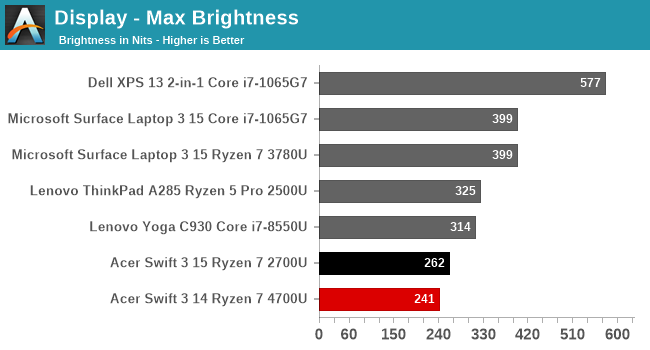
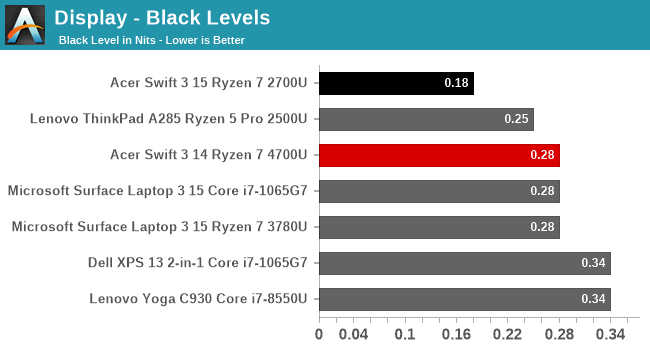
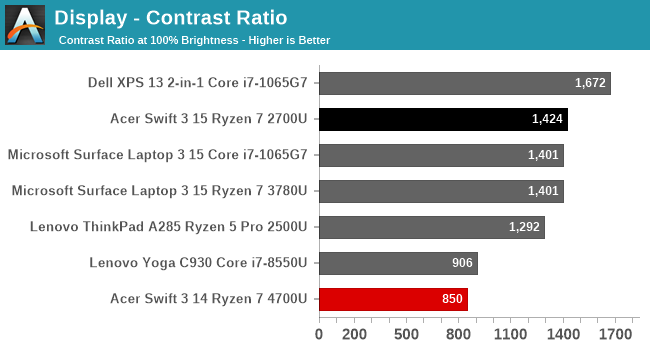
The Acer Swift 3 does not get off to a great start. In a budget notebook, displays tend to be one of the first things on the chopping block. Luckily, we’ve moved past the era where these types of notebooks would offer 1366x768 TN panels, but Acer’s 1920x1080 IPS choice doesn’t offer very good black levels, and their backlight is somewhat weak. It is an inauspicious start.
Grayscale

Grayscale measures the laptops ability to display white levels, from 0% (black) to 100% (white), and the Swift 3 performs quite poorly here. The blue levels are far too strong across most of the range. Gamma is also way off of the expected 2.2 level.
Gamut
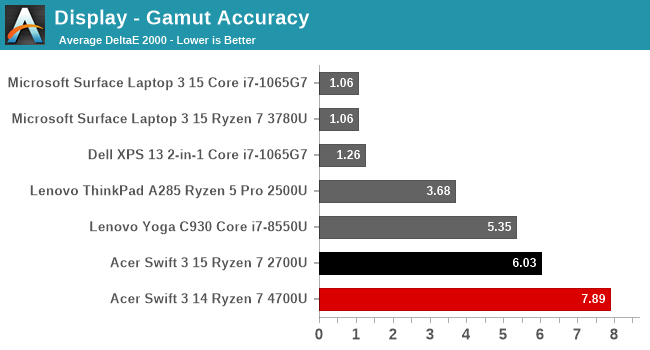
Windows 10 is still an sRGB system first and foremost, so proper sRGB gamut support is required for proper color accuracy. The Acer Swift 3 unfortunately does not cover anywhere near the sRGB gamut, which means that the LED backlighting was likely another area where some money was saved. Although grayscale can be salvaged with some ICC profiles, without full sRGB backlighting this laptop would likely suffer further if an ICC was applied because it simply cannot cover the entire sRGB spectrum.
Saturation
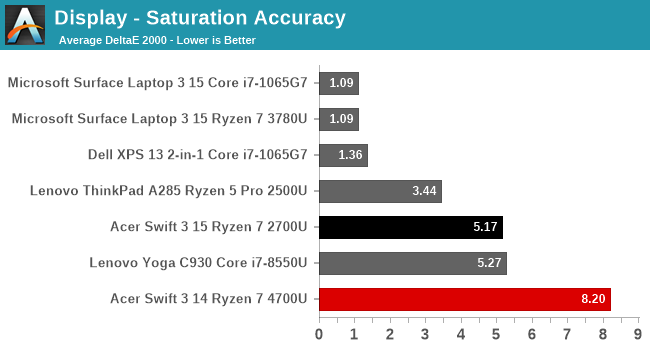
The saturation test covers the primary and secondary colors, but unlike the gamut where they are just measured at 100% level, we test them on 4-bit steps from 0% to 100%. Since we’ve already determined the laptop can’t hit the full sRGB gamut, it is no surprise to see the saturation sweeps suffer.
Gretag Macbeth
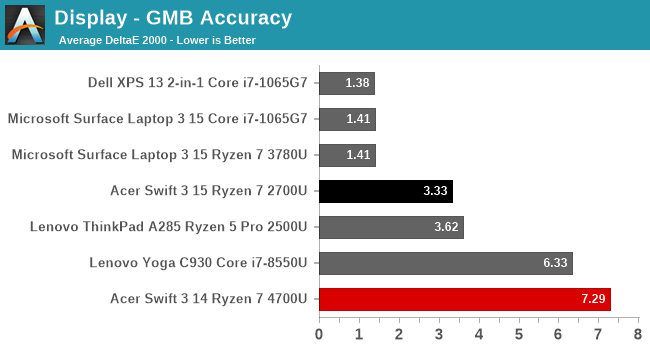
The Gretag Macbeth tests colors off of the primary and secondary axis, including the important skin tones, but with a display that can’t reproduce the entire sRGB range, the Acer Swift 3 naturally performs quite poorly on this test.
Colorchecker
Finally, we have the colorchecker, where you can more easily visualize the color errors with this display. This is a relative test, since any errors in your own display will influence the result, but on the bottom of the swatches is the color requested, and the top shows the color produced by the display. It is not pretty.
Display Conclusion
Overall, despite the poor showing here, the display is in-line with expectations at this price point. Over the last couple of years, there has been a push for better displays, and laptop makers have made the jump to 1920x1080 IPS panels pretty much across the board; so even though this display is poor compared to better IPS-based laptops, it still does offer the good viewing angles an IPS panel enjoys, and 1920x1080 works very well on a 14-inch screen size.
The very poor backlighting really does hamper the capabilities of this notebook. If you wanted to use it for editing photos or video, the internal components like the CPU, memory, and GPU, really would help, but the included display with its lack of sRGB coverage would certainly hinder the work. For basic office tasks, or even gaming, most people who are looking at a laptop at this price point will likely not be too concerned about the display, but just be aware that this one is deficient in several areas.


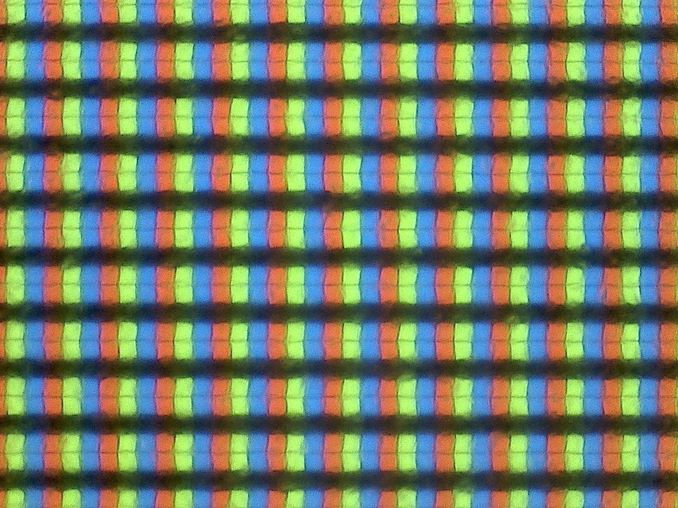













191 Comments
View All Comments
neblogai - Tuesday, May 5, 2020 - link
If you are interested in such things- check this video about the same laptop: https://youtu.be/awPI4RzKMvY?t=386 (use autotranslate). Basically- he put a thermal pads on the heatpipe so it transfers heat to the aluminum back cover. This allowed higher Cinebench result from cold and also higher and more consistent results in Cinebench loop. Before this modification- two of the 30 CB results were ~10% and 7% lower than others (4:40), while after the modding- all scores were higher, and without drops. Also- with this modification, bottom obviously got warmer, so this is not a solution for everyone.eastcoast_pete - Tuesday, May 5, 2020 - link
Thanks, that is an interesting review and modification. As you stated, the reviewer mentioned (assuming I can trust Google translate of the captioning) that this simple addition of thermal pads reduced the erratic thermal throttling a lot, and how little it would add to the BOM costs. Too bad Acer hasn't taken him up on his suggestion! I would pay an extra $5 for that; it's well worth it.anonomouse - Tuesday, May 5, 2020 - link
Any chance of memory latency and memory bandwidth comparison charts between the machines used in the SPEC2017 page? Would be interesting/useful to see these charts taking into account the performance on memory bound workloads, even if the Ice Lake part is using LPDDR4 and not DDR4 like the other two.wordlv - Tuesday, May 5, 2020 - link
Xps 13 runs @25w. This is known fact!hanselltc - Tuesday, May 5, 2020 - link
What the hell is the laptop doing with its thermal management? The SoC Temp FC5 just doesn't match up with the wattage it is drinking. Is the fan curve bad? Does the chip just flips out when it needs to balance CPU and iGPU powerdraw while it is hovering around the hard throttle temp limit?eastcoast_pete - Tuesday, May 5, 2020 - link
I found that link posted by neblogai a few comments up really informative! Apparently, Acer left a lot of potential, yet straightforward heat dissipation on the table.Hulk - Tuesday, May 5, 2020 - link
AMD is obviously on a roll but looking at these Ice Lake results I'd say Intel ain't dead yet. We have a fight on our hands!watzupken - Wednesday, May 6, 2020 - link
"AMD is obviously on a roll but looking at these Ice Lake results I'd say Intel ain't dead yet. We have a fight on our hands!"Firstly, I don't think it is a good comparison between a top end laptop running the top end Intel Ice Lake chip, and this low end Swift 3, running a mid high end Renoir chip. Top end laptops normally put in more care when it comes to cooling, and I believe this Dell model may be using a dual fan cooling solution despite its small and slim size. The cooling will certainly help improve sustained and burst performance, which in turn affect the benchmark scores. From my experience, Acer Swift 3 typically employs a single fan, single heatpipe cooling solution, which is woefully poor in cooling. If you look at some reviews out there on Ice Lake performance on lower end laptops, you noticed that the sustained clockspeed can go below 2Ghz, which will certainly hurt performance.
Secondly spec wise, the i7 and faster RAMs on the Dell will also give it an edge, against the Ryzen 7 4700U with slower RAM.
In this case, just as the review pointed out in the thermal section, I feel the Ryzen 7 4700U is actually very thermally limited to show its full potential. Hopefully we see other PC makers/ models that will provide better cooling.
Oxford Guy - Thursday, May 7, 2020 - link
Yes, if you limit the AMD chip to 8 watts:"The laptop really struggled with its thermals, dropping the framerate into single digits often. The device attempted to run at around 18 Watts of power draw, slightly over the 15 Watt TDP, but in fact only averaged around 8 Watts during this run."
supdawgwtfd - Tuesday, May 5, 2020 - link
"channels if your router is has the correct capabilities."Wanted! Proof reader/editor.